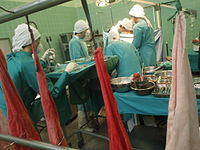
Photo from wikipedia
Background. Despite an increasing demand for liver transplantation in older patients, our understanding of posttransplant outcomes in older recipients is limited to basic recipient and graft survival. Using National Surgical… Click to show full abstract
Background. Despite an increasing demand for liver transplantation in older patients, our understanding of posttransplant outcomes in older recipients is limited to basic recipient and graft survival. Using National Surgical Quality Improvement Program Transplant, we tracked early outcomes after liver transplantation for patients >65. Methods. We conducted a retrospective analysis of patients in National Surgical Quality Improvement Program Transplant between March 1, 2017 and March 31, 2019. Recipients were followed for 1 y after transplant with follow-up at 30, 90, and 365 d. Data were prospectively gathered using standard definitions across all sites. Results. One thousand seven hundred thirty-one adult liver transplants were enrolled; 387 (22.4%) were >65 y old. The majority of older recipients were transplanted for hepatocellular carcinoma. The older cohort had a lower lab Model for End-Stage Liver Disease and was less likely to be hospitalized at time of transplant. Overall, older recipients had higher rates of pneumonia but no difference in intensive care unit length of stay (LOS), total LOS, surgical site infection, or 30-d readmission. Subgroup analysis of patients with poor functional status revealed a significant difference in intensive care unit and total LOS. Pneumonia was even more common in older patients and had a significant impact on overall survival. Conclusions. By targeting patients with hepatocellular carcinoma and lower Model for End-Stage Liver Diseases, transplant centers can achieve nearly equivalent outcomes in older recipients. However, older recipients with poor functional status require greater resources and are more likely to develop pneumonia. Pneumonia was strongly associated with posttransplant survival and represents an opportunity for improvement. By truly understanding the outcomes of elderly and frail recipients, transplant centers can improve outcomes for these higher-risk recipients.
Journal Title: Transplantation Direct
Year Published: 2021
Link to full text (if available)
Share on Social Media: Sign Up to like & get
recommendations!